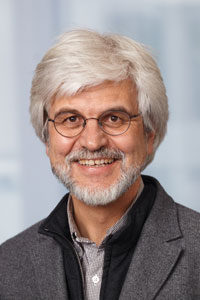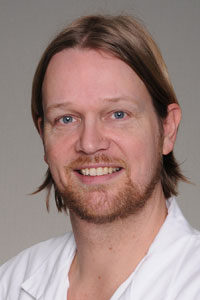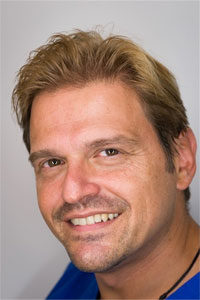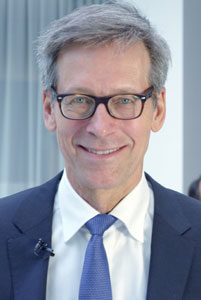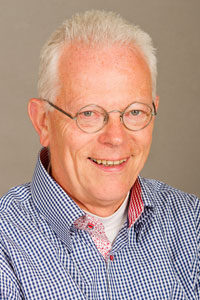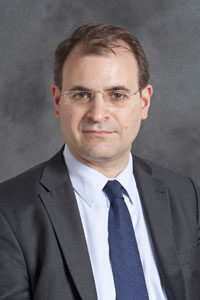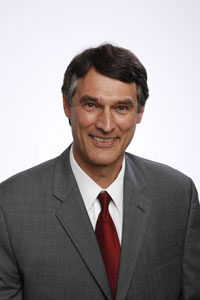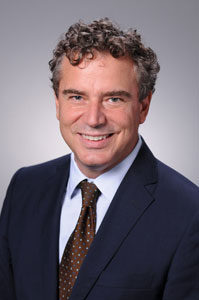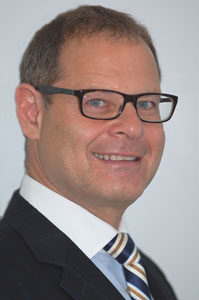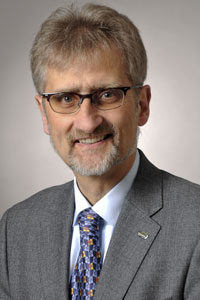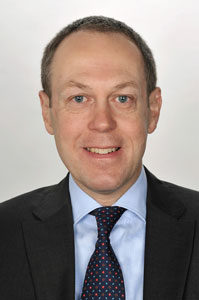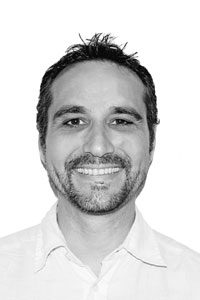SYMPOSIUM SPEAKERS
Thomas Kocher
Professor and Chairman of Department of Restorative Dentistry, Periodontology, Endodontology, Preventive Dentistry and Pedodontics at Dental School, University Medicine Greifswald, Germany
Perspectives on periodontitis. The panorama for the future.
From repeated dental cross-sectional studies, such as NHANES in the United States (National Health and Nutrition Examination Survey), the German Oral Health studies or Jönköping studies in Sweden, it emerges, that the prevalence of periodontal disease decreases. This trend seems to prevail in all industrialized countries. Concomitantly with less periodontitis more teeth are retained, the number of removable prostheses and complete denture decreases. Even subjects with severe periodontitis retain more teeth as shown in Swedish studies. The declining periodontitis prevalence cannot properly be explained, but some possible reasons emerge. Presumably the decreasing smoking prevalence in industrialized countries is responsible for the largest proportion of the decline. Furthermore in most countries the proportion of subjects with a higher education increased (the better educated subjects are, the more they perform self care). Over the last 2 decades the proportion of subjects using interdental cleaning aids and mouthwashes increased. Furthermore the number of filled and crowned teeth and in parallel the risk for overhangs decreased. Whether a modified extraction behavior, regular professional dental cleanings and periodontal treatment contributed to decreasing periodontitis prevalence, is not known. These „preventive“ factors seem to be more influential than the increase of risk factors obesity and diabetes. Presumably, there are also unknown cohort effects. In aging societies a decreased prevalence may not directly translate into a decreased treatment burden, because seniors with a higher treatment need outnumber adults with decreased treatment need. What effect this lower prevalence has on the dental profession and the dental hygienists, has to be discussed.
Odd Carsten Koldsland
Associate professor, Department of Periodontology at University of Oslo, Norway
Perspectives on peri-implantitis. The panorama for the future.
Even though most dental implants serve their purpose without major complications, peri-implant inflammation is regarded as a frequent finding following oral implant insertion. Both etiology and prevalence of disease is still questioned and the observed occurrence and description of disease seems to differ in published literature. This may be caused by several factors, among others the study population. Dental implant treatment was previously restricted to relatively healthy subjects. Modern society comprises an increasing population of elderly and medically compromised subjects with dental implant restorations. Changes in demographics will imply new challenges. Clinical difficulties regarding treatment of medically compromised subjects with dental implants will be discussed as will the etiology of peri-implant disease.
Francesco D´Aiuto
Professor of Periodontology and Head of the Periodontology Unit at UCL, London, UK.
Periodontitis/peri-implantitis – a threat to general health
Oral diseases including periodontitis affect the majority of the population at some time and they are a huge burden both on individuals and on society generally. In the last decade the importance of oral health as an essential component of the overall systemic wellbeing has increased. A bulk of evidence suggests that periodontal diseases may play a significant role in a variety of other health problems. Could this be true also for peri-implant inflammation?
Could these associations be explained by other common risk factors (for example smoking or obesity)? Nevertheless, body inflammation could be linking periodontitis and other systemic diseases. Patients gather information via the available media (newspapers, blogs and internet) and are ever becoming aware of these possible links. However this information is often biased and open to ambiguous interpretation.
Oral health professionals should be confident in answering/addressing their patients on the clinical and scientific relevance of these associations. Hence a critical review of the available evidences is provided. The results of most the data are broadly inconclusive. Indeed the ultimate proof of a causal link is still missing. A better understanding of these associations would surely enable clinicians to provide better care for their patients.
Søren Jepsen
Professor and Chairman Dept. of Periodontology, Operative and Preventive Dentistry, at the University of Bonn, Germany
Adjunctive systemic antibiotics in periodontal/peri-implant disease therapy – time to rethink?
A large number of randomized clinical trials and systematic reviews with meta-analyses have clearly established that adjunctive systemic antibiotics combined with mechanical debridement offer additional clinical improvements compared to scaling and root planing alone. These effects are more pronounced in aggressive compared to chronic periodontitis and in initially deep pockets, whereas more limited additional improvements were documented for moderately deep sites. The marginal clinical benefit in patients with moderate disease has to be balanced against their side effects. Notably it has to be realized that an increasing number of warnings have been articulated against the unrestricted use of antibiotics in treating periodontal diseases because of the emerging global public health issue of bacterial resistance. In the surgical treatment of peri-implantitis adjunctive systemic antibiotics are widely used. However, their benefit still remains to be established, as there is only very limited evidence from randomized clinical trials.
Ubele van der Velden
Prof. Em. dr. Ubele van der Velden, Professor of clinical periodontology at ACTA, Amsterdam, The Netherlands
Has the decision on tooth extraction in treatment planning changed over time and will it change in the future?
Without professional interference, tooth loss is the result of oral diseases during life. However, most teeth are lost due to extraction by a (dental) professional. Apart from emergency tooth extractions to treat pain, mostly due to caries, the decision to extract teeth is based on a great number of variables. This varies from health care insurance systems and dental mindedness of a population to the specific problems of a patient and the capabilities of individual dentist. Most importantly, tooth extraction depends to a major extent on decisions taken by patient and dentist. The introduction of dental implants had major impact on the decision of tooth extraction in treatment planning because (extended) bridgework was no longer needed. Therefore, since the 1980s hundreds of thousands dental implants have been placed. However, it can be questioned whether the number implant placements will in- or decrease in the future. This item will be discussed in the presentation.
Nikos Donos
Professor and Chair of Periodontology & Implant Dentistry and Head of the Clinical Oral Research Center at the Institute of Dentistry, Barts & The London School of Medicine and Dentistry, Queen Mary University of London, UK.
Is there a need to place bone grafts in extraction sites to minimize reduction of ridge dimensions?
In recent years, the increased demand for aesthetics in procedures related to implant dentistry has created the need for developing techniques that will facilitate optimal aesthetics together with maintenance of alveolar bone volume prior to the placement of implants.
Recently, alveolar ridge preservation has been extensively reviewed in the literature. A number of surgical procedures involving different bone grafting procedures with or without the combined use of GBR have been evaluated in preclinical and clinical studies with varying degrees of success in maintaining the socket dimensions.
In this lecture, the healing outcome following different ridge preservation protocols involving bone grafts and their impact in relation to implant dentistry will be critically appraised and clinical guidelines will be provided.
Thomas F. Flemmig
Professor and Dean, Faculty of Dentistry, The University of Hong Kong and Director of the Prince Phillip Dental Hospital, Hong Kong SAR.
Disruptive Technologies in Periodontal Therapy
Science and technology continuously advance in most if not all industries including, healthcare. Many of the advances made are incremental in nature and improve the performance and/or lower the costs of well-established products or services. Disruptive technologies are those that create new applications or markets and ultimately, make established technologies obsolete. At an early stage, disruptive technologies often perform worse than established technologies, but have attributes that are of value in new markets or for new applications. The performance of truly disruptive technologies often improves rather quickly and over time, surpass that of established technologies. Examples of disruptive technologies in periodontal therapy will be presented and an outlook provided on which recent advances hold promise to disrupt periodontal therapy in the future.
Giulio Rasperini
Associate Professor in Periodontology, Dept. of Biomedical, Surgical and Dental Sciences at University of Milan, Milan, Italy. Adjunct Clinical Associate Professor, University of Michigan MI, USA.
Is the concept of tissue engineering the future strategy in reconstructive periodontal therapy?
Tissue Engineering is the use of a combination of cells, engineering and materials methods, and suitable biochemical and physicochemical factors to improve or replace biological tissues. This science and technology has given us the chance to create new therapeutic scenarios for our patients by simply implementing the use of scaffolds in everyday clinical practice. Growth factors have also been extensively studied and have been presented as a powerful tool for tissue regeneration. Unfortunately safety concerns from regulating authorities and high costs have limited the use of these biological products to few practices. More advanced methods as image based scaffolding, cell therapy and gene therapy are being evaluated in research institutions. Will they become available to the population in a foreseeable future? Or will this research just give very encouraging results with little transition to clinical practice?
Ann Wennerberg
Professor and Head of the Department of Prosthodontics at Faculty of Odontology, Malmö University, Sweden.
What is the optimal future dental implant?
One of the most difficult things is to look into the future. An optimal implant must be something like a tissue engineered tooth using stem cells. Attempts have been made in this direction, but so far this solution seems to be very far away. However, in more recent future there are some promising new materials that may find applications within implant dentistry. PEEK (Poly Ether Ether Ketone) and some magnesium alloys are such examples. Both PEEK and magnesium alloys have the advantage of an E-modulus close to human bone although the possible implant application for the materials may differ. Advantages and disadvantages of these new materials will be discussed during the presentation.
Michael R. Norton
Private practice, London, UK. Adjunct Clinical Professor at the University of Pennsylvania Dental School, Philadelphia, USA.
Single Tooth Implant Restorations in the Aesthetic Zone – Risk & Rewards
As we push the boundaries for rehabilitation with dental implants, we have seen a significant trend towards achieving optimal aesthetics. Reduced healing times, immediate placement, and most significantly immediate restoration have found favour in an attempt to save time, to reduce tissue loss and to provide an instant fixed esthetic solution.
This lecture will look at the risks and rewards associated with these procedures and assess whether our focus on short-termism to satisfy perceived patient demands presents any future problems or dilemmas.
Matthias Kern
Professor and Chairman of the Department of Prosthodontics, Propaedeutics and Dental Materials at the Christian-Albrechts University at Kiel, Germany.
Single tooth replacement in the esthetic zone using resin-bonded fixed dental prostheses – a realistic alternative?
Resin-bonded fixed dental prostheses (RBFDPs, so-called Maryland bridges) with two metal retainer wings have been introduced over 40 years ago for a minimal invasive replacement of missing teeth. However unfortunately due to various reasons metal-ceramic RBFDPs are not considered a comparable treatment modality to implants by most of the dentists.
Cantilevered RBFDPs with a single ceramic retainer wing were introduced 20 years ago. They provide better esthetics and are less invasive than two-retainer RBFDPs. In the meantime long-term data of this minimal invasive treatment option are available that show outcomes comparable to single tooth implants when replacing incisors. Similar concepts are now also implemented for the replacement of premolars and canines that show promising medium-term outcome. This lecture summarizes when RBFDPs present a favorable and less costly treatment alternative to single implants.
Giovanni E. Salvi
Associate Professor and vice chairman, Department of Periodontology, School of Dental Medicine at University of Bern, Switzerland
Will it be possible to prevent peri-implant diseases?
Peri-implant diseases have been defined as (i) presence of mucosal inflammation around osseointegrated implants without loss of supporting bone (i.e. peri-implant mucositis) and (ii) presence of inflammation with additional loss of supporting bone (i.e. peri-implantitis). Furthermore, peri-implant diseases are initiated and modulated by the presence of similar factors as those involved in the development of periodontal diseases. Hence, control of conditions such as plaque accumulation, history of periodontitis, cigarette smoking, compliance with supportive care and cleansability of restorations represent the target in order to prevent onset and progression of peri-implant diseases. The aim of the present lecture is to provide a summary of available evidence on the possibilities to prevent peri-implant diseases.
Olivier Carcuac
Research associate, Department of Periodontology, The Sahlgrenska Academy at University of Gothenburg, Sweden. Private Practice, Dubai, UAE.
Is successful outcome of surgical therapy of peri-implantitis predictable?
Peri-implantitis is a disease affecting peri-implant tissues and is characterized by bleeding/ suppuration on probing together with loss of supporting bone. Recent evaluations on the prevalence of the disease indicate that 15% of implant-carrying patients present with overt peri-implantitis. This underlines the necessity for predictable methods for treating this biological complication. The combination of self-performed and professional infection control procedures is the main focus of treatment strategies. Surgical procedures should be considered if the pathology persists after non-surgical therapy. However, according to the literature, there is limited reliable evidence suggesting which could be the most effective intervention for treating peri-implantitis. The presentation will address surgical therapy of peri-implantitis and treatment outcomes reported in pre-clinical in vivo experimental studies and clinical trials will be presented. Factors influencing resolution of peri-implantitis following surgical therapy and results from follow-up studies will be discussed.

